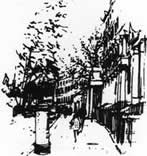
Thomas Pakenham
This is from an article in Ladbroke News published shortly after Thomas was appointed our President in 2011.
Thomas Pakenham was born in 1933. After Oxford he set out on his travels in Africa and the Middle East and began his career as a writer with a travel book on Ethiopia, The Mountains of Rasselas. He worked for a time as a journalist on the Sunday Times and the Observer. After inheriting the family estate in Ireland, he moved there and took up farming and planting trees. Trees remain one of his abiding interests and in 1996 he published Meetings with Remarkable Trees, which has been translated into several languages and made into a television series. As well as two further books on remarkable trees, he has also published a number of extremely well-regarded history books, including The Scramble for Africa (1991).
In 1970, Thomas and his wife Valerie and their children moved back to London as he was just beginning a book on the Boer War, which meant several years of research in London record offices and libraries. It was then that he moved into a small house with an elegant Regency bow at the leafy end of Ladbroke Grove, and became involved in the Ladbroke Association, very shortly after it was founded, and subsequently served as our chairman for a number of years.
In 1975 the family moved from Ladbroke Grove to Elgin Crescent, buying a house in the crescent for £55,000. “My wife was murmuring that our house in Ladbroke Grove was getting too small. And the smell of the lorries accelerating up the hill lay heavy on the air of our basement kitchen. So one morning I said: ‘Give me that list of houses for sale. I’ll bet you a bottle of Guinness I can buy you a new house – and be back here in half an hour.’ And I did and I was. You see, 111 Elgin Crescent had been gutted by the previous owner, who lived next door. It was first on the house agent’s list. So I walked round to see it, and after five minutes I said: ‘Yes, I’ll buy it. Here’s a 10% deposit.’ And I put a cheque on the owner’s desk. He was somewhat astonished. ‘Don’t you need a survey?’ To which I replied: ‘What is there to survey?’ You see, apart from the roof (leaking badly) and the basement floor (needing new concrete) there was very little to survey: no floors, no doors, no ceilings. I was back in half an hour, as I had promised. And it proved the best buy I ever made. It looked south-east across the communal garden, a peach of an 1860 terrace house, although all its plasterwork had been scraped off. (We did our best to restore it.) But I don’t think I got the Guinness – not that day, at any rate.
How much has Elgin Crescent changed over the last 35 years? Very little, I’m glad to say. We’ve lost the elderly rag-and-bone man, who used to drive his horse and cart down the street with a mysterious, primeval cry. (I suppose he was merely urging us to bring out our rags and bones.) The elm trees died in the communal garden, as they died all over England. But we filled the gaps with some newcomers, including a mulberry to celebrate the Queen’s Silver Wedding (and the Ladbroke Association, at my suggestion, presented a memorial mulberry for each of the 15 communal gardens). In Elgin Crescent, as in the rest of the conservation area, we were fighting a long war of attrition with the Council. A war? No, perhaps we were merely trying to save the Council from itself. We were determined, at any rate, to save the terrace from further erosion. And sometimes we succeeded. For example, we persuaded the Council to use their discretionary power, at long last, to stop people planting the family Mercedes in the front garden. So at least we saved the best of the front gardens, with their Saucer magnolias, Snakebark maples and Judas trees, from being progressively concreted over. And we helped keep open some of the crucial gaps between sections of the terrace, the gaps through which you see tantalising glimpses of the communal gardens, those secret gardens which are the jewels in Ladbroke’s crown.”
Winter 2011
